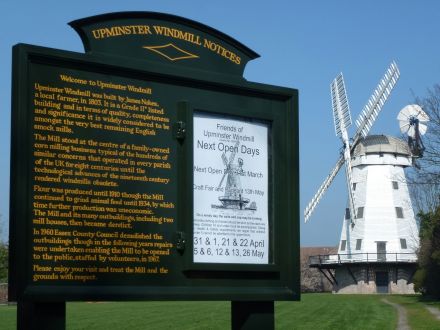
Upminster Windmill is considered to be one of the finest examples of a "Smock" windmill remaining in England. It was built in 1803 by James Noakes, a local farmer. Additional milling capacity was provided by the building of a steam mill in 1811.
In 1849 the mill estate was put up for auction by James' son Thomas, expenditure on improvements having led to a large mortgage. The estate was purchased for £2,000 by Ambrose Coleson who shortly afterwards sold it to James Wadeson.
In 1857 Thomas Abraham, who had worked as foreman for Thomas Noakes in 1844, purchased the Mill and the immediate surrounding land for £1,100 - being unable to raise the £1,900 for the entire estate.
Thomas Abraham died in 1882 and the business passed to his younger son John Arkell Abraham who ran the business until his death in 1912. His two nephews Alfred and Clement succeeded to the business, Alfred being the miller and Clement looking after business matters.
The business became uneconomic and was auctioned December 1934 being purchased by Mr. W. H. Simmons who intended to develop the mill field but leave the Mill intact. In 1937 the Mill was purchased by Essex County Council who intended to demolish it. Local interest was aroused and Hornchurch Urban District Council started a fund for preservation of the Mill.
Nothing was done to the Mill during the War and a restoration committee was established in 1948. A millwright, Hector Stone had been working on the Mill since 1946 with the hope of getting it to work again. Hector Stone died in 1952 and the plans of the committee failed due to a variety of reasons.
The Mill continued to deteriorate and in 1960 Essex County Council, with a more enlightened policy than in 1937, purchased additional land and demolished the Mill house, the steam plant and all the other out-buildings.
Major repairs to the Mill were carried out in 1962 including rebuilding of the "reefing" gallery at first floor level.
With the creation of Greater London in 1965 the Mill became the property of the London Borough of Havering who carried out further repairs to make the Mill safe for visitors.
In 1967 the Hornchurch & District Historical Society opened the Mill to the public as part of the Havering Arts Festival and the Society and, through the Windmill Sub-Committee, have continued to do this on a regular basis ever since.
In 1970 one of the "stocks" supporting the sails cracked and new stocks and sails were fitted over the following two years. The sails are now again deteriorating noticeably.
Further repair work was carried out in the next few years, the last major repair being the re-building in 1983 of the fan stage which supports the fan-tail at the rear of the cap. A section of one of the main timbers (known as 'cant' posts) which support the weight of the cap and sails and also the intermediate floors with their machinery was replaced at the same time.
The Windmill Sub-Committee have kept a watch on the condition of the Mill and in 1995, with the help of experienced friends, they carried out a survey of the Mill. Their report was submitted to the London Borough of Havering in 1996 a copy being sent to English Heritage.
No Comments Yet - Why not be the first to leave a comment
Every effort is made to make sure that all the information is correct but we strongly recommend that you call Upminster Windmill before you set off on your day out to confirm opening times and admission prices.
Please also note that the position on Google maps for Upminster Windmill is a rough estimate using their postcode in the database and might be slightly out.
It may also be worth clicking the web link for Upminster Windmill to see if there are any special events coming up or currently on.